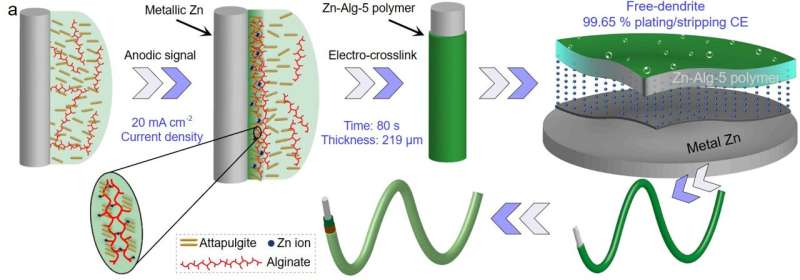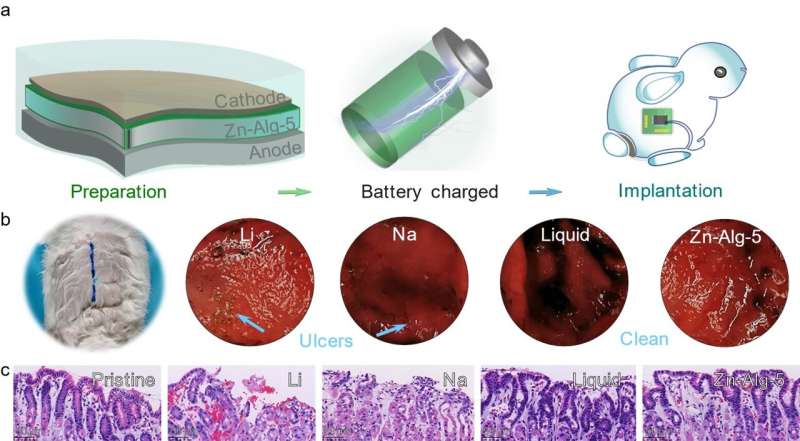This article has been reviewed according to Science X's editorial process and policies. Editors have highlighted the following attributes while ensuring the content's credibility:
fact-checked
trusted source
proofread
Biocompatible zinc batteries with Zn-alginate polymer electrolyte

Implantable and wearable electronics have opened an array of opportunities for controlling disease conditions and health monitoring, but the unceasing battery-induced safety poses a formidable barrier to application, especially for biomedical devices.
In many cases, there are potentially devastating complications associated with the toxic and unstable batteries lodged in the organics, resulting in corresponding liquefactive necrosis, tissue destruction, and explosively burn-related injuries. Therefore, biosafety energy storage systems are urgently needed to be pay enough attentions.
Aqueous zinc-based (ZBs) batteries attract increasing attention for potential applications in modern wearable and implantable devices due to their intrinsic safety, high capacity, and stability. However, how to address the issues of biosafety design and inadequate electrochemical performances of ZBs need to be further improved when moving to practice, especially for wearable and biomedical devices.
In response to this challenge, recently, the energy team led by Professor Jiang Zhou from the Central South University (CSU), China, proposed a green and programmable electro-crosslinking strategy to prepare a Zn-alginate polymer electrolyte for biocompatible Zn batteries based on the superionic binding of alginate carboxylate groups with free-Zn2+, activated by electro-oxidation.

By using this method, within a short time of 80 s, a stable polymer electrolyte with a regulated channel was directly obtained on the surface of metal Zn. The as-prepared electrolyte provides high reversibility of 99.65 % coulombic efficiency, over 500 h long-time stability.
Importantly, after 6 hours of exposure to the negative face of the battery cycled with the as-prepared gel electrolyte, minimal mucosal injury was observed in the rabbit models, showing that the as-prepared gel electrolyte is a biocompatible material that does not have any significant corrosion in the slightly acidic environment of the digestive system.
The new strategy to prepare the Zn-alginate polymer electrolyte has three prominent advantages over the conventional methods: (1) the cross-linking process for the synthesis of electrolytes avoids the introduction of any chemical reagents or initiators; (2) a highly reversible Zn battery is easily provided from a micrometer to large scales through automatic programmable strategy; and (3) high biocompatibility is capable of implanted and bio-integrated devices to ensure body safety.
The work is published in the journal National Science Review.
More information: Xuesong Xie et al, Biocompatible zinc battery with programmable electro-cross-linked electrolyte, National Science Review (2022). DOI: 10.1093/nsr/nwac281


















